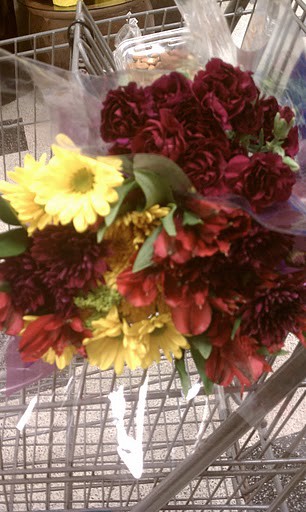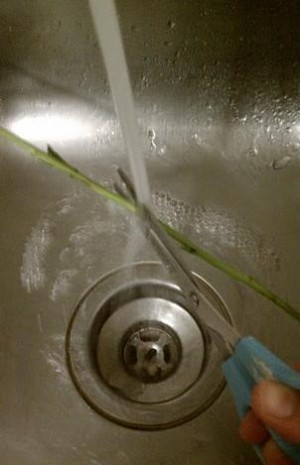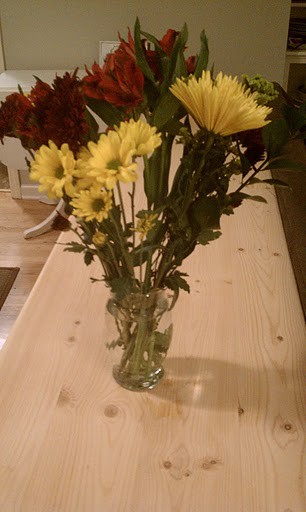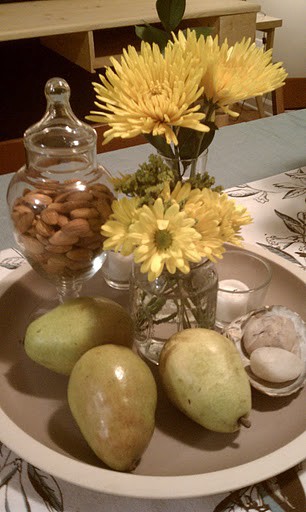Cheap, Cheerful Flowers For Your Next Party
Cheap, Cheerful Flowers For Your Next Party
by Emerson Beyer

Autumn is here. It’s time to finish that Campari and buy a bottle of Calvados for a new round of cocktails. Cookout weather is ending, and dinner-party season beginning — now is when cut flowers become most needed! But what if you only have time (or budget) to pick up a bouquet from the grocery store? You’ve surely stood in front of those refrigerator cases, sarcophagi of pastel tissue paper, baby’s breath and disappointment, your Martha Stewart fantasy shattered.
Steel yourself, dreamer! From this unpromising sight, you are going to make floral alchemy happen. For less than $20 — maybe even less than $10 — along with patience, some advice and the contents of your crisper drawer, you will be able to craft a centerpiece that makes guests feel so welcome that they will radically improve the quality of wine they bring over. In time for your weekend dinner party, here’s your step-by-step guide to making flower magic.
Step 1: Tidy up your home. If your space is in disarray, flowers will add to and not detract from the mess. Before you go flower shopping, throw away all the junk mail that has piled up. Clear everything from your table except linens and candles. Do the dishes, because you’re going to need an empty sink and some counter space.
Step 2: Shop frugally and conscientiously. Naturally, shopping at the farmer’s market is great, but it’s not convenient or affordable for everybody, and I’d love for you to make flowers an ongoing part of your life. On the other hand, shopping at the supermarket or bodega means you’re likely to find environmentally terrible flowers grown far away with loads of fertilizer and pesticide.
The simplest thing you can do to reduce your environmental impact (not just from flowers!) is to buy less. You don’t need a Volkswagen-sized arrangement in your cozy apartment. The bouquet in your hands may not look big, but that’s because you’re standing in Costco. Plus: these flowers are not going to hang around forever — this is not the place to make an investment.
The other important thing you can do — and this will benefit the environment, your wallet and the longevity of your arrangement — is to choose flower varieties carefully. At this time of year, lilies, mums, zinnias and sunflowers are low-impact, in season, and grown domestically. (Peonies and dahlias are easy on the environment but tend to be expensive.) Carnations are always in season, always cheap, environmentally okay, and can be very pretty if arranged thoughtfully. (In the spring, choose daffodils over tulips.)
I strongly advise against certain flowers. Cheap roses never last, because they are handled too roughly and not “hardened” properly. I can never make hydrangeas look good nor last more than a few days. Gladiolas signal death. Lilies actually cause death to household pets.
Step 3: Pick your palette. This is perhaps the key to pulling off cheap flowers: choose a single variety (a bright panoply of zinnias would look great) or a single color (yellow Peruvian lilies, button mums and anemones).
Here are the two palettes I chose to demonstrate. Total cost: $13.

Some flower snobs will say that you must never buy a bouquet already arranged. Listen, you are not going to plop this bouquet into a vase. You are going to take it apart and use its components. A bouquet can give you several varieties in reasonable quantities for the price of an overabundance of one thing; daisies, for example, always seem to come in regrettable bulk. A bouquet will also provide some greenery that may come in handy. Choose a bouquet that sticks to a narrow spectrum, and avoid any that feature “glamour” flowers like roses, because those may be disguising expired specimens.
Step 4: Accessorize! While shopping for flowers, you are probably surrounded by produce; grab some durable fruits or vegetables that coordinate with your flowers. Citrus fruits, hard squashes, apples, avocados, eggplants and Borlotti beans can complement your blossoms at minimal cost — and, unlike flowers, don’t have to go to waste. Coordinate colors or just add green. Avoid heavy-handed seasonal “themes” like sunflowers with pumpkins. Bright green poms (a kind of chrysanthemum) with Granny Smith apples may be a less clichéd vision of autumn. For this demonstration, I spent $6 on pears, onions and nuts.
Step 5: Containment. Think small. Think narrow. These qualities will help you keep your flower arrangement under control. Many floral containers are seductive when empty but devilishly hard to use: anything shaped like a trumpet or bucket, say. A jar with “shoulders” (think applesauce or pickles) is perfect. A straight-sided or bubble-shaped bud vase can hold a handful of flowers, not only a single, forlorn blossom. Instead of fitting all your flowers into one container, use a few small, mismatched items as containers.
Fill the container(s) 3/4 of the way with cool water. Use half of the little flower-food packet that came with the flowers, and save the other half for later.
Step 6: Cutting. You’ve probably heard it stated that flower stems must be cut at an angle with a sharp knife under water. In my experience, there is no harm in cutting the stems with ordinary scissors under a running faucet. Indeed, there is one enormous advantage to this technique, which is that it is easy, and this ease will encourage you to have more flowers in your life.


The easier way. The “correct” way.
Before cutting anything, pluck most of the leaves from the stem — all but those nearest to the flower. Leaves make the vase water icky and the arrangement noisome. Ultimately, you want no leaves below the water level. Be thorough, but be careful not to brutalize the stem in the process.
As a general rule, you want only the blossom and an inch or so of stem to reach above the lip of the container. If it’s too tall, keep snipping. Test and snip, test and snip. Don’t be timid! If your trimming results in leaves below the water line, pluck those leaves. Most people are too cautious about cutting, and as a result their flower arrangements look sparse and weedy. Next time you see a shabby centerpiece at a party, take note of the stem length; chances are this is a store-bought bouquet that has not been aggressively trimmed.

Don’t do this.
Step 7: Presentation and maintenance. Now comes the easy part, just put everything together on your table. Having a tray like this one wouldn’t hurt, but it’s not necessary. If you have a small, healthy houseplant, add it to the scene. Every few days when you see the water get cloudy, remove the flowers, thoroughly clean the containers, rinse the stems and trim another 1/4 inch.
If several flowers have wilted, consolidate the survivors to one smaller container. Most arrangements can be made to last two weeks or longer.


Final Reminders
Important:
• No leaves below the water line.
• Use a clean container.
• No lilies if you have pets.
• Shorten stems aggressively.
Unimportant:
• Cutting stems at an angle with a sharp knife.
• Making the cut underwater.
K. Emerson Beyer, environmentalist and gadabout, lives in Durham, N.C. and tweets as @patebrisee.
